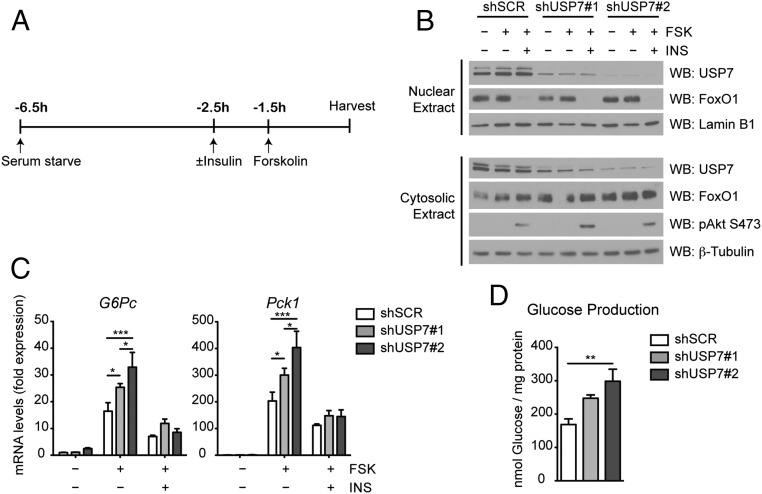Figure 3.
USP7 knockdown increases gluconeogenic gene expression and glucose production in primary hepatocytes. A, Schematic of forskolin (FSK) and insulin (INS) treatment of primary hepatocytes. To mimic fasting conditions, cells were serum-starved in 0.2% BSA for 5 hours prior to a 1.5 hours incubation with 10 μM forskolin. To analyze the effect of insulin on suppression of gluconeogenic gene induction, cells were serum-starved for 4 hours prior to a 1 hour pretreatment with 100 nM insulin followed by a 1.5 hours incubation with both insulin and forskolin. B, Insulin signaling in primary hepatocytes with USP7 knockdown. Western blot analysis of nuclear and cytosolic fractions from hepatocytes as treated in (A). C, USP7 knockdown increases gluconeogenic gene expression upon forskolin treatment. Primary hepatocytes were infected with control (shSCR) or USP7 shRNA adenoviruses and subjected to the conditions presented in (A). mRNA levels are graphed relative to expression of unstimulated/serum-starved shSCR and presented as average ± SEM; n = 3. *, P < .05; and ***, P < .001 by one-way ANOVA with Newman-Keuls Multiple Comparison test. Data are representative of at least two independent experiments. D, USP7 knockdown increases glucose levels in medium after overnight forskolin treatment. Glucose in medium of primary hepatocytes treated overnight with 10 μM forskolin was measured 3 hours after culturing in glucose-free medium supplemented with pyruvate and lactate. Presented as average ± SEM; n = 3. **, P < .01 by one-way ANOVA with Newman-Keuls Multiple Comparison test.

